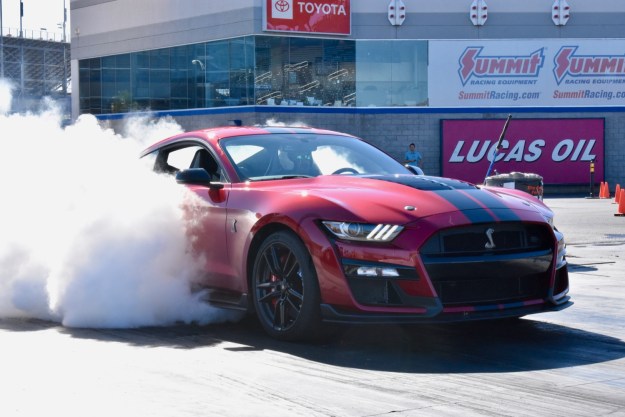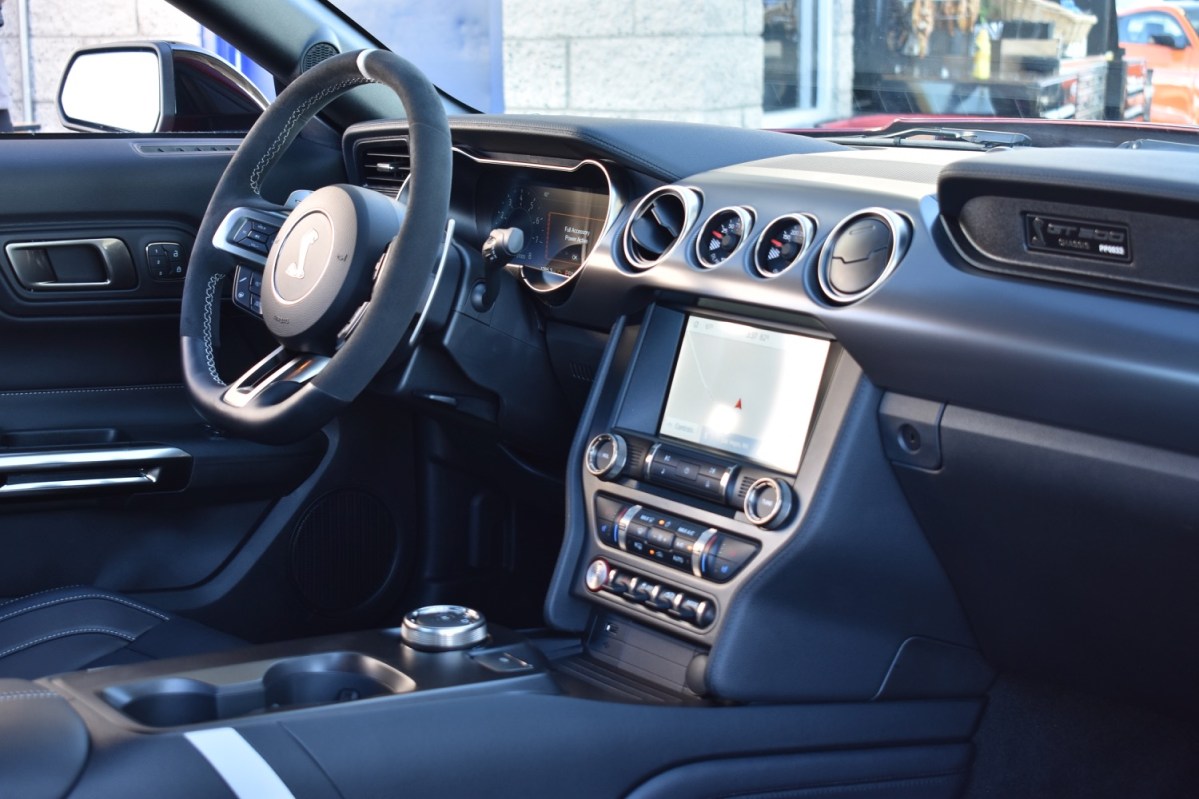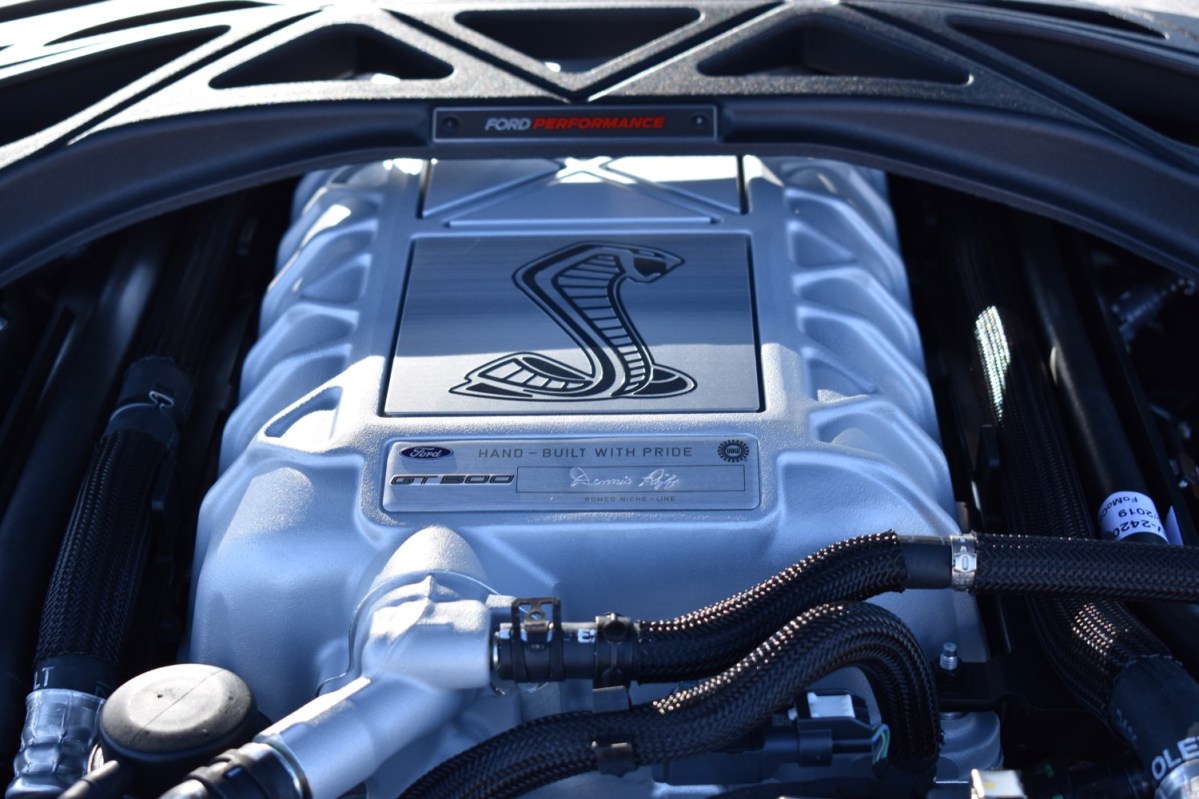
“The Ford Mustang Shelby GT500 is an incredible ride that offers no excuses, and needs none.”
- Ridiculous power
- Confidence-inspiring handling
- Great brakes
- Mean looks
- Hilariously bad gas mileage
- High price
“This isn’t your grandpa’s GT500,” Jim Owens, Ford Mustang marketing manager, declared at the launch of the latest 2020 Shelby GT500. He wasn’t kidding.
Launched in 1967, the original Shelby GT500 is among the most coveted nameplates from the golden era of American muscle cars. It set a precedent for big power and big fun. The last Shelby GT500, launched in 2013, was a 662-horsepower monster with a claimed 200-mph top speed. This time around, Ford didn’t just want a car that would go fast in a straight line. It wanted a car that could do everything, from tackling corners to comfortably cruising down the highway. Ford wanted both brawn and brains.
The new 2020 Ford Mustang Shelby GT500 has insane power – 760 hp, to be precise, making this ‘Stang the most powerful Ford production car ever. But it also has downforce-generating aerodynamic aids, and tech designed to help the driver keep the shiny side up. Is that enough to tame all of that power? Can it justify the Shelby’s $71,395 base price? And can the best of Ford outperform the hottest Chevrolet Camaro or Dodge Challenger? We excitedly hit the track to find out.
Looking the part
The GT500 has traditionally been the flagship Ford Mustang, but recent models haven’t really conveyed that status with their styling. Since Ford brought the GT500 back in 2007, the cars have featured relatively mild styling tweaks over lesser Mustangs. That changes with the 2020 model. This car’s aggressive looks match its performance, and they even help the GT500 go faster.
The first thing you notice when walking up to the GT500 is that the front end is mostly open space. The openings are twice as large as the already big-mouthed Shelby GT350 Mustang according to Ford. This allows more cooling air to pass into the engine bay. A bulge in the hood gives that air a path to escape, and adds clearance for a supercharger. Six heat exchangers keep the engine, transmission, supercharger, and oil nice and cool. Ducts on either side of the grill direct air to the brakes, ensuring they stay cool as well.

Ford also worked to maximize aerodynamic downforce, helping the car stick to the pavement and corner faster. They may look like a random collection of parts from Pep Boys, but the GT500’s front splitter, sill extensions, rear diffuser, and rear spoiler (as well as a belly pan) all work together to generate balanced downforce. Even the hood vent helps reduce front end lift, according to Ford. The optional Handling Package adds a rear spoiler with a Gurney Flap – a lip on the trailing edge of the spoiler that improves performance. The Carbon Fiber Track Package adds a larger rear spoiler based on the Mustang GT4 race car’s rear wing, as well as carbon fiber wheels.
While the exterior is pumped up, the interior is mostly standard Mustang. The GT500 does get some special touches, including carbon fiber trim, and the transmission uses a rotary shifter lifted from other Ford models, but the layout will be familiar to anyone who has driven a current-generation Mustang. That’s not a bad thing as far as usability, but it does mean the GT500 isn’t really a step above other Mustangs when it comes to tech. You get the same Sync 3 infotainment system (with standard Apple CarPlay and Android Auto) used in countless other Ford vehicles, and the same digital instrument cluster available on other Mustang variants. It all works very well, but it’s a bit disappointing to see the same tech as a base Mustang in a car costing about twice as much.

At least the interior works well for what it was designed to do. Both the standard seats and optional Recaro seats have generous side bolstering, but they’re both still comfortable enough for a long drive. Because this is still a Mustang, you get a decent-sized trunk and a roomier interior than most sports cars, as well as back seats a human being may actually be able to fit in (unless you order the Carbon Fiber Track Package, which deletes them to save weight). The Mustang can’t compete with the Dodge Challenger on interior space, but the Dodge’s sheer size makes it unwieldy in the corners.
Heart of the beast
Every Shelby GT500 is defined by its engine, and the 2020 model has one of the all-time greats. Ford took the symphonic 5.2-liter flat-plane crank V8 from the Shelby GT350 and topped it with a 2.65-liter Eaton supercharger to suck in more air. The result is 760 hp and 625 pound-feet of torque. That’s more than any Ford production car ever – including their GT supercar.
Ford doesn’t get ultimate muscle car bragging rights, though. While 760 hp is a lot, it’s not enough to surpass the Dodge Challenger SRT Hellcat Redeye’s 797 hp and 707 lb-ft, and the GT500 only beats the Chevrolet Camaro ZL1 on horsepower (the Chevy makes 650 hp and 650 lb-ft).
Another strike against the GT500, at least in the eyes of forum denizens, is its transmission. While Chevy and Dodge both offer manual transmissions, the GT500 is only available with a Tremec seven-speed dual-clutch automatic. Fans may be frustrated by the lack of a clutch pedal, but this transmission is no slushbox. Preferred by the likes of Ferrari and Porsche, the dual-clutch setup is exactly what it sounds like: one clutch disengages a gear, while the other engages the next one. That allows for shifts as quick as 80 milliseconds, according to Ford. That’s much quicker than any human can change gears.

“You’re not even going to be able to press the clutch of a manual transmission in 80 milliseconds,” Carl Widmann, Ford Performance chief engineer, said regarding the decision to go with a dual-clutch gearbox. The Tremec transmission can also handle the full force of the V8’s 625 lb-ft of torque at all times, and is more tunable than other transmission types, Widmann said. The numbers tell the story.
Ford claims the GT500 will do zero to 60 mph in 3.3 seconds, and run the quarter mile in 10.7 seconds. For reference, a Camaro ZL1 does zero to 60 mph in 3.5 seconds and runs the quarter in 11.4 seconds, according to Chevy. Dodge claims a Challenger SRT Hellcat Widebody will do zero to 60 mph in 3.4 seconds, and run the quarter mile in 10.8 seconds. Ford also quotes a top speed of 180 mph for the GT500, compared to 203 mph for the Hellcat (Chevy doesn’t publish a top speed estimate for the ZL1).
To reign in all of that power, Ford equipped the GT500 with truly massive brakes. The front rotors measure 16.5 inches in diameter, meaning they’re about the same size of the wheels on an original 1967 Shelby GT500 Mustang. The rotors – and their attendant six-piston Brembo calipers – require 20-inch wheels, as they wouldn’t fit inside anything smaller, according to Ford.
Power with poise
So Ford stuffed plenty of power under the GT500’s hood, but what about their goal of making this latest Shelby Mustang more than just another drag race specialist? Ford achieved that, and more. A car with this much power, and without the added traction of all-wheel drive to tame it, might sound intimidating. Never has 760 hp seemed so approachable.
Our time with the GT500 started with a drive up twisty roads from Las Vegas to the top of nearby Mount Charleston. Driving a car with the optional Handling Package and standard Michelin Pilot Sport 4S tires, we were amazed by how civil the GT500 felt. The rumbling V8 provided the appropriate soundtrack, but it wasn’t accompanied by the wind noise and back breaking ride that are often the price of admission in hardcore cars like this. The car’s MagneRide adaptive suspension does a great job of balancing handling with ride comfort. Shifts from the dual-clutch transmission were smooth and quick. In automatic mode, the transmission will even kick down a few gears while decelerating ahead of a corner – exactly what a human driver would do when shifting manually.

With our appetite whetted, we headed to the track. The road course at Las Vegas Motor Speedway that Ford booked is tight and technical. It seems like a great place for a Mazda Miata, not a 760-hp Mustang. Unbelievably, this is where the Shelby GT500 really shines.
Our track time was spent in a car equipped with the Carbon Fiber Track Package (which includes stickier Michelin Pilot Sport Cup 2 tires) in Track mode. This turns off traction control and stability control, but keeps them ready to intervene, just in case. Even with the safety net pulled back, we felt confident lapping this beast around the tight track. The precise steering and excellent body control afforded by the MagneRide suspension makes the GT500 feel like a much smaller car. We also appreciated that the steering doesn’t feel overly heavy in Track mode, as is often the case with the sportiest driving modes of other performance cars. The brakes erase speed so efficiently that it feels like driving into a tractor beam. Overall, the drama-free experience had us thinking not of other muscle cars, but of the Nissan GT-R. The GT500 goes about its business in the same nonchalant way as Nissan’s supercar.
You have no need to fear that 760 hp, either. The car feels very neutral in most situations, and even when you do overcook it, the GT500 gives you plenty of warning. You can clearly feel when you’re approaching the limits of grip, giving you plenty of time to make corrections and avoid losing the back end. It won’t just step out of line abruptly on you. We did notice understeer in some situations, but that’s much safer than the oversteer that could send you spinning into a barrier.

After the road course, we headed over to Las Vegas Motor Speedway’s drag strip to test out some other fun features. One of those features is the line lock previously seen on other Mustang models. This locks the front brakes while letting the rear wheels spin freely, making for effortless burnouts.
Like many other performance cars, the GT500 also features launch control. Once it’s set up, all you have to do is mash the throttle while holding down the brake pedal. Take your foot off the brake pedal, and you’re away. However, we noticed a slight pause between releasing the brakes and launching, and we still got wheelspin even when launching at relatively low rpm. That may have been partially down to conditions, admittedly. We did our runs relatively late in the day, after the surface had heated up and been trodden on by many other cars, making it a bit slipperier. That, combined with our high-altitude location, meant attempting to match Ford’s quarter-mile claim wasn’t a possibility.
The practical stuff
One thing the 2020 Shelby GT500 has in common with its 1967 ancestor is an epic thirst. We saw 8.6 mpg on our road drive, and triggered a low fuel warning message (signifying less than 50 miles of range) after just a couple hours of (admittedly aggressive) driving. EPA fuel economy figures for the GT500 aren’t available yet, but the bar is pretty low. Both the Chevy Camaro ZL1 And Dodge Challenger SRT Hellcat are rated at 16 mpg combined.
The Shelby GT500 is a driver’s car, but that means it doesn’t come with many driver aids. You can’t get adaptive cruise control, and blind spot monitoring is only available as part of the optional Technology Package.
Ford offers a three-year, 36,000-mile, bumper-to-bumper warranty, and a five-year, 60,000-mile, powertrain warranty. Chevy and Dodge offer identical coverage for the Camaro and Challenger, respectively. All three American muscle cars have something else in common: a reputation for below-average reliability.
Crash-test ratings for the 2020 Shelby GT500 aren’t available at this time. Other versions of the current-generation Mustang have received good ratings from the National Highway Traffic Safety Administration (NHTSA) and Insurance Institute for Highway Safety (IIHS), however.
How DT would configure this car
Our ideal Shelby GT500 would have the optional Technology Package ($3,000), which adds navigation, blind spot monitoring, and a 12-speaker B&O audio system, and the Handling Package ($1,500). The latter includes a Gurney flap and front splitter wickers that add extra downforce. We would skip the Carbon Fiber Track Package, as its Michelin Pilot Sport Cup 2 tires don’t work well on the road, and the $18,500 asking price is pretty steep. This package is only worth the extra money if you plan on driving a GT500 primarily on racetracks.
Summary
The GT500 has incredible power and the reflexes of a race car, but what really sets it apart is its approachability. Despite having over 700 hp, the Shelby is still a normal car when you need it to be, and it lets even a novice driver have lots of fun. If you want a purer driving experience, Ford still offers the Shelby GT350 Mustang, complete with a manual transmission and naturally-aspirated engine.
Should you get one?
Yes. This Mustang does it all.


